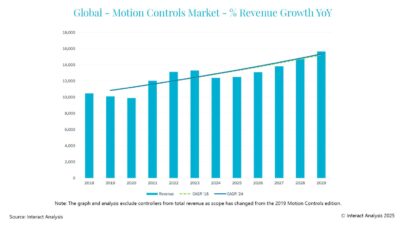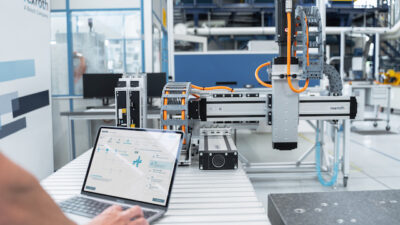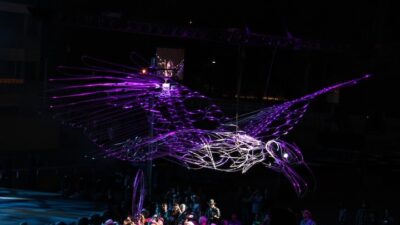"Lack of standards" is a complaint often heard in the motion-control arena. Given the kaleidoscope of technologies and products that comprise this sector, the comment isn't surprising. However, if one includes proprietary approaches and de facto standards, plus various communications buses used in motion control, then probably there are too many "standards" out there.
Typical Standards Sources
APS www.aps.anl.gov IEC www.iec.ch IEEE www.standards.ieee.org/micro SERCOS N.A . www.sercos.com NEMA www.nema.org NIST www.isd.mel.nist.gov PLCopen www.plcopen.org
In some cases, downloading of publications is free.
This article is an expanded version of the July 2002 Control Engineering`s Back to Basics department .
”Lack of standards” is a complaint often heard in the motion-control arena. Given the kaleidoscope of technologies and products that comprise this sector, the comment isn’t surprising. However, if one includes proprietary approaches and de facto standards, plus various communications buses used in motion control, then probably there are too many “standards” out there.
Standards and application guidance for motion control come from numerous sources. Those aimed at the core of motion control are explored here. Communication methods, for example, although vital, are not an exclusive concern in motion systems.
One core area of motion systems is the overall architecture, where centralized and distributed are the two main directions. Distributed architectures have drawn a lot of attention lately, due to advances in the digital world that allow local embedding of intelligence and other benefits.
Top-down approaches
PLCopen (Zaltbommel, Netherlands; www.plcopen.org ) of several vendor- and product-independent organizations involved in standards-recently expanded its scope to motion control. Its well-known IEC 61131-3 standard for PLC programming languages also is used to program servo motion systems, as reported in CE’s June 2002 cover article on “Electric Servos.” Ladder logic, structured text, and sequential function charts are some standardized languages used in motion system programming.
PLCopen’s new activity is the specification of “Function Blocks for Motion Control,” released as version 1.0 in November 2001. A library of function blocks based on IEC 61131-3 covers single-axis motion control as well as coordinated, multi-axis control. These motion control blocks work like flowcharts to help develop control logic. The method seeks to standardize interfaces among different motion control approaches and promote greater reuse of application software- besides merely specifying programming languages.
www.arcweb.com/omac ) is another initiative with a top-down approach to standardization. This association of users, OEMs (original equipment manufacturers), vendors, and system integrators encompasses motion control among its tasks. Packaging machinery and related package printing and converting equipment have drawn current interest for standardization. One of OMAC’s 10 user-directed working groups-Packaging Workgroup-is pursuing “a common approach” to developing future equipment of this type. Focus is on electronic controls from servo technology and common programming languages for motion controllers.
Among projects of the Packaging Workgroup will be the evaluation of PLCopen’s motion control specifications (Function Blocks) through pilot tests at manufacturing plants. Project goals will be to verify “savings attributable to these specs in programming, maintenance, and reuse of code,” according to OMAC. ARC Advisory Group (Dedham, Mass) hosts OMAC’s Web site.
Another OMAC working group, API WG, has the task to develop an application interface, which will define control modules and their interface specifications to permit full interoperability among such controller modules. The API addresses servo-drive control of industrial machinery.
Servo and stepper motors; electric drives
Motors are covered under various standards. For example, NEMA Standard Publication ICS 16-2001, “Industrial Control and Systems, Motion/Position Control Motors, Controls and Feedback Devices,” is a recent, extensive look at these three “interconnected components” of a motion control system as defined in this publication. In particular, NEMA ICS 16 issued by the National Electrical Manufacturers Association (Rosslyn, Va.; www.nema.org ) addresses requirements for “control motors” by various categories, such as all servo motors; all stepping motors; brush-type servo; and brushless servo. Controls and position/velocity feedback devices (rotary encoders and resolvers) are also covered. A comprehensive section on definitions and terms adds to the usefulness of the publication, which replaces the older NEMA MG7 standard.
Another NEMA source, “Application Guide for AC Adjustable Speed Drive Systems,” aids the selection of these drive systems rated up to 600 volts. Here, “systems” refer to three-phase induction motors; voltage-source, pulse-width modulated (PWM) adjustable-frequency controls; and associated components. The guide addresses common issues to consider when selecting drive system components and when installing or applying an entire drive system.
A further resource guide to motion-control technology, products, and applications is NEMA’s “Programmable Motion Control Handbook.” This 100-plus page publication contains applications, vendor references, standards, and a glossary.
The International Electrotechnical Commission (Geneva, Switzerland; www.iec.ch ) is the source for a vast array of IEC standards. Among its offerings for the motion-control sector are standards on adjustable-speed electrical power drive systems and various electric motors. For example, IEC 61800-2 provides rating specifications for low-voltage, adjustable-frequency ac power drive systems up to 1,000-V input.
Communications; other standardization
One communication standard developed specifically for motion control is SERCOS (SErial Realtime COmmunication System), which works as an interface among motion controllers, digital drives, and other system components. SERCOS is based on fiberoptic ring architecture, and now offers message transmission rates up to 16 Mbit/sec. Supporting organizations for this protocol are Interests Group Sercos (Stuttgart, Germany; www.sercos.org ) and, in North America, SERCOS N.A. (Bloomingdale, Ill.; www.sercos.com ). SERCOS claims sole international recognition in the motion-control sector through its designation as IEC Std. 61491.
IEEE Std. 1394, “High-Speed Serial Bus” (FireWire), developed by the Microcomputer Standards Committee of the Institute of Electrical and Electronics Engineers (IEEE, New York, N.Y.; www.standards.ieee.org/micro ) for other applications, also has a following in motion control and servo systems. A major benefit of this standard is its high-speed data transmission with rates up to 400 Mbit/sec. While the basic protocol of FireWire is open, specific implementations by vendors are not interchangeable.
Various other communication methods are applied in motion control, as well. They fall into the categories of, de facto, industry, and proprietary “standards.” And the search for still more capable and compatible communications buses continues.
The Intelligent Systems Division, Manufacturing Engineering Lab of NIST (National Institute of Standards and Technology, Gaithersburg, Md.) is a further source of related material. NIST publication “Motion Control Standards” provides an excellent overview of the standards “landscape”-including a summary of the numerous associated communication standards, (see www.isd.mel.nist.gov/projects/openarch/motstds.doc ). NIST is also cooperating with OMAC to generate an application interface for motion systems mentioned above.
CAN in Automation (CiA, Erlangen, Germany; www.can-cia.com/cia ) promotes the marketing of CAN (Control Area Network) serial bus and its products. CiA develops and supports various CAN-based higher layer protocols. The non-profit association also administers the CANopen specification, which serves as a simplifying tool to implement CAN projects. CANopen allows direct peer-to-peer data exchange between nodes, and its network management functions help smooth start-up and operation.
Significant to this arena are two CANopen Device Profiles, specifically for Drives and Motion Control (DS 402) and for Encoders (DS 406). These device profiles define basic functions and parameters that can help standardize the implementation of a motion system. The DS 402 profile specifies various operating modes, such as profile position, interpolated position, profile velocity, and profile torque. It includes an object dictionary, and allows for manufacturer-specific objects. Multi-axis coordinated motion is also covered. These device profiles are available through CAN in Automation.
A set of motion standards from the Advanced Photon Source (APS) research facility of Argonne National Laboratory (near Chicago, Ill.; www.aps.anl.gov ) is worthy to note. An in-house development, APS standards provide a consistent interface to motors-typically of the stepper variety-used by collaborative teams of scientists working at stations located all around an approximately 1-km circumference ring that produces high-energy x-rays for research. “APS standards” are intended to allow scientists to move their equipment (and motors) from one experiment area to another; also to swap similar components, without special cables, connectors, or lengthy setups.
“The experiments are done in locked, shielded enclosures, requiring a fully automated remotely operated motion control and data acquisition system for each setup. The idea was that scientists in one experimental area should be able to take a piece of equipment from their area and connect it in a different experimental area without special cables, connectors, etc.,” says Kurt Goetze, of the Beamline Controls and Data Acquisition Group, Advanced Photon Source, at Argonne National Lab. “The results of this standard so far have been positive,” adds Mr. Goetze.
What’s ahead for motion control standards? Formal recognized standards are evolving, albeit slowly. The complex technology issues involved, as well as the desire of suppliers to protect their investments, affects the pace of progress. Also missing is a unifying body to integrate various separate developments-and new initiatives still to come-into a cohesive whole for the benefit of users.
– Frank J. Bartos, executive editor [email protected]



